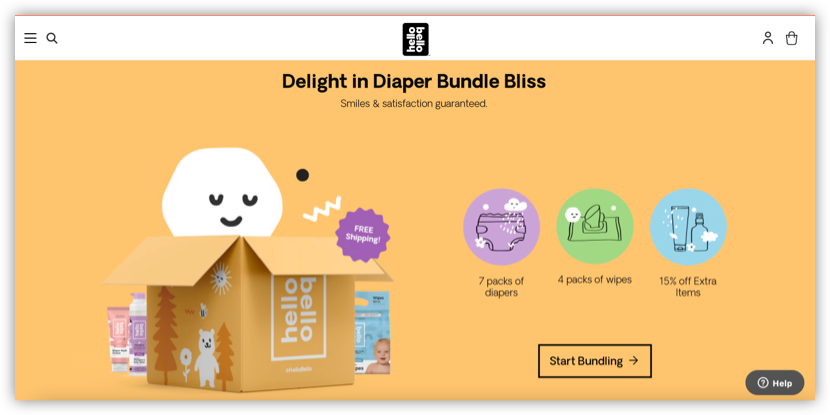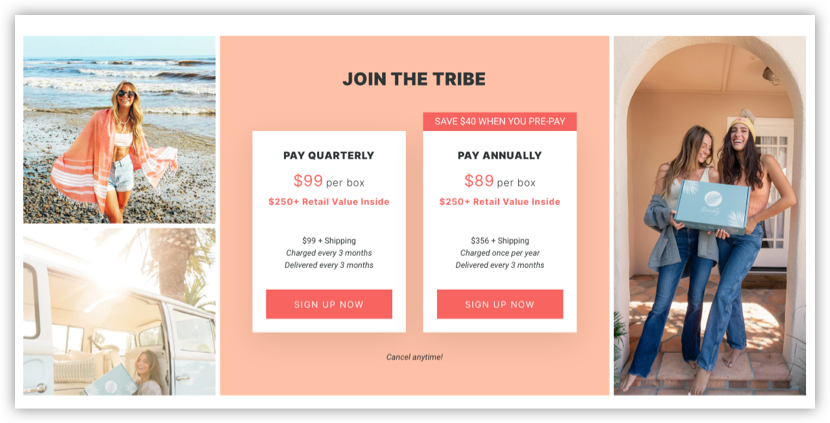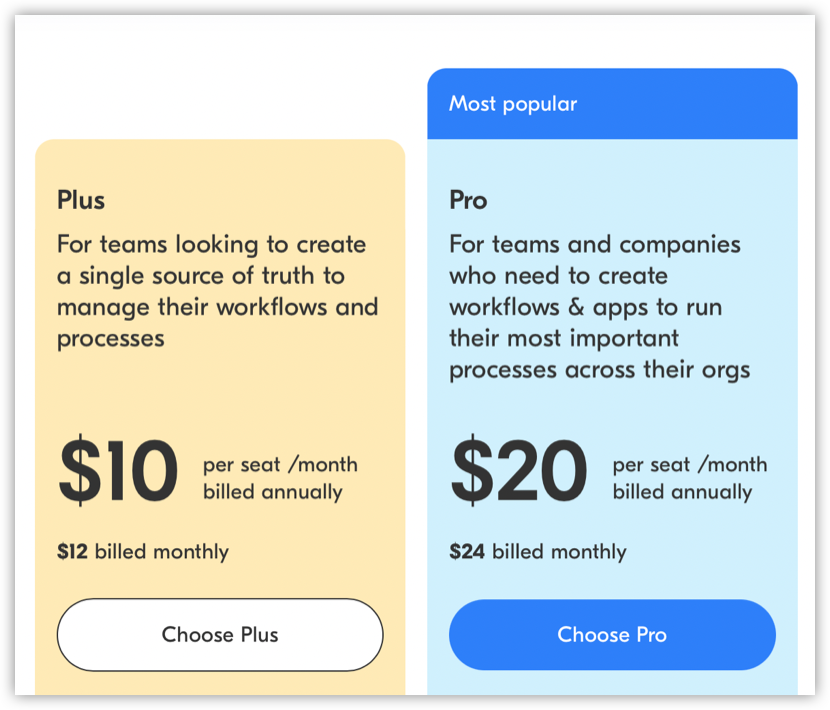
SUBSCRIPTION BUSINESSES
The ultimate guide to the subscription business model
The subscription ecommerce market is projected to rise over 3000% by 2025, according to a McKinsey & Company report. If you’re thinking of building a subscription business to capitalize on the market’s unwavering growth, check out this guide for strategies and insight into how to create a successful subscription business.
Subscription businesses aren't just having a moment; they're here to stay. Convenience culture has always been a core consumer value, but lately, it has surged from a power walk to an all-out Olympic-level sprint. According to the Subscription Commerce Conversion Index, the average consumer has doubled their retail subscriptions from two to five subscriptions since the first quarter of 2021.
According to McKinsey, the subscription ecommerce market is projected to rise over 3000% by 2025, from $15 billion in 2019 to $473 billion, which means there's a huge demand and opportunity for existing businesses and subscription founders to make recurring revenue.
If you're a subscription startup or looking for a way to add recurring revenue to your existing online store, you're in the right place. Exploring a subscription-based business model is an agile move to improve your cash flow with recurring revenue, control your average order value, and increase customer loyalty.
In this guide about subscription businesses, we'll talk about the different opportunities within the market to prepare founders and executives to build a thriving subscription business. We'll explore topics like:
Types of subscriptions and their pricing strategies
Benefits of offering subscriptions on your products
Evaluating your current product viability for subscriptions
Creating a flawless customer experience
Managing and fulfilling your subscription orders
Ecommerce trends
Top tools for subscription businesses
A subscription business model is a means to give shoppers on your store the ability to purchase products in an automatically recurring way, usually at a discounted price. This amplified convenience turns one-time shoppers into repeat customers and secures you predictable monthly revenue. It's no secret that it's more expensive to acquire new customers. Hence, subscriptions are a significant growth strategy to ensure built-in loyalty and recurring revenue to create high lifetime customer value.
Popular examples of subscription businesses are music and video streaming services like Spotify and Disney+. Still, subscription businesses can offer almost any product on a recurring basis and have been around for decades. However, subscription businesses have boomed recently, especially after a life of living at home for over two years. There are four subscription product categories:
Service subscriptions (Music and streaming services)
Information subscriptions (Magazines, newsletters, etc.)
Consumable subscriptions (Meal boxes, cleaning supplies)
Durable goods subscriptions (Clothing boxes)
As we continue to digitalize our economy, convenience and membership culture grow. This continuing digitalization means that more than half of consumers fall into the Early Adopter/Early Majority segment of business and tech adoption.
We are at the cusp of a convenience boom, and opportunity is everywhere. Just take a look at your household. Do you have your groceries delivered, or maybe cleaning supplies and pet food replenished every month? If you have a bit more disposable income, you probably treat yourself to a Wine of the Month Club box.
What is a subscription business model?
What are types of subscription models?
The three subscription models are:
Access
Curation
Replenishment
While there are four product categories for subscriptions (service, information, consumable, durable), there are three main subscription models. Each has its unique selling point (USP), and the one that's right for your business depends on your product category. Every shopper has a subscription, whether you're a fashion lover, cinephile, whiskey connoisseur, or simply someone brushing their teeth.
Subscription models
| Model | Product category fit | Description | Customer benefits | Merchant benefits |
|---|---|---|---|---|
| Access |
|
This subscription gives customers access to an exclusive community and perks, which is the main selling point of this type of subscription. |
|
|
| Curation |
|
These subscriptions offer a surprise and delight factor to subscribers with new and personalized items. |
|
|
| Replenishment |
|
A subscription for frequently bought commodities like cleaning products, diapers, razors, etc. |
|
|
Replenishment subscription companies
Bite Toothpaste: A replenishment subscription company with an eco-friendly focus to offer plastic-free toothpaste bits.
Dollar Shave Club: A replenishment subscription company that sells personalized Shaving products.
Hello Bello: A replenishment subscription company selling personalized diapers, wipes
and other baby needs.
Thrive Market: A members-only online subscription market to access savings perks on natural and organic consumables.
JustFab: A hybrid curation-access subscription company selling shoes through a
members-only club with access to VIP prices and events.
Curation subscription companies
Casely: A curated subscription selling trendy phone cases so customers can express
and change their style with a new monthly case.
Birchbox: A curated subscription company selling beauty and skincare samples.
Access subscription companies
6 benefits of subscription and membership models
1. Sustainability
There are multiple creative ways you can implement and benefit from sustainability with your subscription company. Look at how On Shoes helps its customers with sustainability. According to the shoe company, you should replace a well-worn pair of trainers every six months. Their subscription service sends you a new pair of shoes every six months and lets you send your old On pair back to them
in the same packaging. They then recycle the old shoes and build a great relationship with their customers.
Subscription models also contribute to sustainability by allowing companies only to sell core items in a subscription, rather than having the pressure of coming out with new collections or products every season and encouraging over-consumption.
2. Recurring revenue
Recurring revenue from memberships and subscriptions allows you to create financial stability and only warehousing the lowest number of products for the maximum number of users. Recurring revenue also contributes to some predictable financial forecasting.
3. Community and loyalty-building
There are several proven ways that subscription services build customer loyalty; surprise and delight, convenience, and discounts. When done right, subscription companies are essentially the "Holy Grail" of customer loyalty, especially when the company is purpose-driven with a cause their customers care about.
4. Valuable data insights
When personalizing a subscription box, a good strategy is to have customers fill out a quiz or form to determine their product preferences. This information allows you to send out an ultra-coveted subscription box. It also lets you enhance your marketing opportunities and discover how to engage better with your community.
5. Reducing costs
Because of the recurring nature of subscription orders, financial forecasting is predictable, and reducing costs is more achievable as the business ages. You can reduce waste and overproduction since you'll know how much inventory to purchase or manufacture. Another way subscription reduces cost is by lowering acquisition costs since your customers are usually repeat customers. According to
Profitwell, the membership industry had one of the lowest churn rates in the market at 6.27% in 2021.
6. Successful promotions
Subscription models make it easier to have successful promotions. It's excellent at facilitating new product discovery and cross-selling or upselling. Look at how GoodFood is winning at upselling by offering convenient one-off grocery items with their meal kit subscription boxes.
How to sell your subscriptions online
The opportunities and commercial advantages of the membership economy make incorporating a subscription model an irresistible business decision. As with any critical business decision, whether you're starting a subscription business from scratch or incorporating the model into your existing e-commerce store, there are a few things that are essential for you to evaluate when getting started:
Type of subscription you'll offer
Pricing strategies
Best ecommerce platforms for subscription businesses
Your current product viability
Sourcing products
Securing of capital, if needed
Ecommerce tools, apps, and extensions for:
Recurring payments
Order management and fulfillment
Marketing
Automation
Customer experience
Payment and onboarding
Personalization
Communication strategy
Packaging
Reaping the benefits of a subscription business, like customer loyalty and successful promotions, largely depends on selecting the right e-commerce platform to support your brand. Subscription businesses have slightly different operational requirements than your standard e-commerce store. All subscription ecommerce platforms need to:
Create and manage subscriptions
Automatically charge recurring payments
Allow customers to cancel, change, and renew their subscriptions.
These are the best ecommerce platforms for subscription businesses, and we'll explain why:
General ecommerce
Shopify
WooCommerce
Wix
Specialized
Podia
CrateJoy
Best platforms for subscription businesses
Shopify
Shopify is arguably the top ecommerce platform, accompanied by an App Store packed with world-class tools to help manage subscriptions. It's effortless to set up a subscription business on Shopify. There are various apps to browse, from ReCharge Subscriptions for recurring payments to product recommendation quiz apps for a
unique and personalized onboarding experience.
How to easily set up a subscription business on Shopify
WooCommerce
WordPress is already a famous website builder with a built-in CRM. Adding WooCommerce for ecommerce paired with the WooCommerce subscriptions app gives you subscription features and support that allows for:
Sign up fees
Free trials
Recurring pricing
Customized billing periods
Subscription length
Wix
Wix has a built-in feature for physical subscription products. It allows you to set a billing period, subscription length, and additional discounts for specific subscription products. Wix also connects to payment gateways that support recurring payments like Stripe and PayPal.
Podia
If you're entering the access subscription market, Podia is a top ecommerce platform for selling subscriptions to online sources, webinars, and digital downloads. It also has over 4000 integrations with Zapier to personalize the ecommerce experience.
CrateJoy
CrateJoy is an excellent platform if you're entering the market. You can make your ecommerce website for your subscriptions and take advantage of their sellers' marketplace for access to an ultra-targeted and engaged audience. While creating your ecommerce store, CrateJoy will guide you with best practices for creating a Successful business.
Which type of subscription and pricing strategy will you offer?
Your subscription pricing strategy depends on your business goals and target audience. For example, you might be more interested in attracting 50% more young families to your meal box subscription by the end of this year. When developing a plan for any business, you must establish SMART (specific, measurable, achievable, relevant, time-bound) goals to inform future strategies.
Your goals will influence which pricing structure you choose to help you achieve those goals. Hopefully, you've given some thought to which type of subscription you'll offer:
Access
Curation
Replenishment
There are five strategies for subscription businesses, and you can charge for them on a weekly, monthly, quarterly, or annual basis.
5 subscription pricing strategies
Flat rate
Tiered
Usage-based
Add-on
User-based
1. Flat rate
Like the name, a flat rate subscription pricing model offers one flat fee for every subscription. A flat rate works best for companies that want to keep operations simple or doesn't offer many features (yet) with their product and only target one type of user.
Beachly offers customers a flat rate for their subscription of curated beach boxes, charged either quarterly or annually. For $356/year, beach lovers get a personalized box sent to them every quarter full of beach apparel and accessories.
2. Tiered
Tiered pricing offers different packages of features at varied prices. SaaS companies especially love this pricing strategy to create tailored plans. Take our own product, Edit Order, for example.
Edit Order is an advanced order editing, automation, and order management app for Shopify and Shopify Plus merchants, which offers two different packages:
Standard at $29/month
Growth at $49/month
Professional at $99/month
Premium Plus at $249/month
Offering customers a tiered option is flexible and increases your customer base by creating tailored plans to their specific needs. When you give customers the option to upgrade or downgrade their tiered plan, this also increases their lifetime value.
3. Usage-based
Like pay-as-you-go phone plans of yore, usage-based plans charge customers based on their product or service consumption. This model gives customers a lot of flexibility and is excellent if you target customers with a wide range of usage. Think of your household utility bill. Every month the price varies based on your use. Usage can depend on different factors like the season, your travel, health, etc.
4. Add-on
This strategy takes flat rate pricing up a notch and allows customers to add other features or products to the base price. Add-on pricing is a preferred strategy for a price-conscious audience with a wide range of feature/product needs.
If you run a meal box company, you could use an Add-On pricing model for your meal kits. There is a flat monthly rate for standard meal boxes, with the ability to add other grocery items to their order at an extra cost.
5. User-based
As the name conveys, user-based pricing charges per product or service user. User-based pricing is a great model for many SaaS products that require collaboration, like Airtable, which offers plans priced per user. As your user-base increases, this model lets you scale simply and predictably.
Evaluate your current product viability
Evaluating the market's ripeness for your current product offering to determine if it's viable for the subscription market is a critical step before launching your subscription business. Capitalizing on the boom in the subscription market is a smart play, but you don't want to end up like a tulip bulb trader in 1638 - broke from the market bubble burst. You have to determine:
Your competition
Is the market saturated with the competition?
Is your unique selling point strong enough to survive in a saturated market?
Has anyone in your product niche attempted subscriptions yet and been successful?
Target audience
Are your customers currently repeat buyers?
Do they have the disposable income for a subscription?
Are they tech-savvy?
What are their primary wants/needs with a subscription? This could help determine your subscription model.
Product
Is there enough markup to offer the product at a discounted subscription price?
Is the product trending?
Are the fragility, weight, and size acceptable for a subscription box with other products?
Is it perishable?
What is the product lifespan? i.e., if you sell a product with an extended warranty, it might not make sense as a subscription item.
Determine if your supply chain can handle subscription operations. Where is it sourced? Can you offer it as part of a subscription box if you dropship?
Is it a seasonal product?
You can make almost any product into a subscription and quickly figure out if it's viable by looking at your competition or analyzing the above questions. Mixing prepared research with creativity is critical; take Nuuly, for example. There are many clothing subscription boxes, but Nuuly was creative and jumped on the sustainability trend by creating a clothing rental subscription box.
Creating a seamless customer experience
It's no secret that Amazon is a big player in the subscription market. Still, other subscriptions companies that might be competing with Amazon's product offering can create a seamless and personalized customer experience to give customers what Amazon can't. A great customer experience is more than just quick product delivery; there are several strategies to get creative with. Consider something free samples or a pre-purchase quiz to build relationships and create something personal.
On the backend
For customers
Customers need a place to manage and view their subscription information. They should be able to cancel, view upcoming deliveries, and change their preferences like sizing. Customers will need a portal to access their account information on your ecommerce store.
For your team
Unless you're operating a company like Bite, your products will change with every new shipment. Your team will have to manage orders and inventory of recurring purchases. To help your team deliver a flawless customer experience, they'll need tools like bundle fulfillment automation for faster order processing and inventory management.
Onboarding and personalization
Onboarding and personalization are critical pillars for customer experience and are where a lot of the buyer journey can drop off. A good onboarding experience will be easy to use and should collect the data you need from your customers to ensure they get the products they need and will also surprise and delight. Critical considerations for an exceptional onboarding experience are:
Create personalized onboarding surveys
Don't overwhelm your customers by guiding them with simple steps for getting started
Upsell during onboarding to increase your average order value, i.e., giving them the option of including
three treats with their dog's subscription box for an extra $1.Anticipate different needs and requirements during your onboarding experience
Show off your brand with your unique design elements during onboarding
Give them an incentive to complete the onboarding journey
Thoughtful packaging
Beautifully designed packaging and thoughtful touches play to the personalization strategy that gets subscription businesses the success they're looking for. Packaging is another ingredient that adds to why customers choose a subscription rather than purchase the product individually: the excitement of receiving a beautiful box packed with curated surprises. Packaging a subscription box has challenges that packaging a single product doesn't include. Boxing multiple products means you need to find a happy medium where products aren't crowded but aren't so spaced out that it looks like the box could be empty.
Subscription boxes don't need to be custom-designed, but it's strongly encouraged to create an exceptional experience. Custom designs are especially favored if you sell curated subscription boxes that surprise and delight to round out the customer experience completely. Some good things to note about shipping subscription boxes:
Ship from a central area if you can to have an accurate cost-per-subscription box budget
Consider partnering with an ecommerce fulfillment company like ShipStation
Create beautiful boxes that are worthy of social media
Consider sustainable packaging like cornstarch packing peanuts
Fostering a community
When building your brand story and nurturing relationships with customers, focusing on issues your customers care about is a powerful community tool. According to a Motista study, customers who have an emotional connection to a brand have a 306% higher lifetime value than if there's no emotional connection. By purchasing from you, your customers know that they're also supporting a cause they care about, like a local charity or climate change.
Subscription businesses, especially those using the access model, can incorporate hyper-personalization like VIP member perks on their favorite products. Tools like product recommendation quizzes are integral in fostering brand community.
Subscription business trends
Every industry has some driving forces that help founders and operators map their goals and adapt their business to ever-changing markets. According to McKinsey, 15 percent of online shoppers have subscribed to an ecommerce service over the past year. Keeping a pulse on current trends like the top-selling product categories in the subscription industry means you can make informed decisions for the success of your subscription business. Dive into four need-to-know trends for the subscription industry:
Spending trends
Churn rate trends
Product trends
Consumer behavior trends
Spending trends
Like most businesses, acquisition and conversion can be challenging, and the subscription market isn't immune to the hardships (though the market excels at customer loyalty and customer lifetime value). According to McKinsey, conversion is weaker in this market: only 55 percent of those who consider a service ultimately subscribe, probably because people are reluctant to sign up for a long-term commitment. Replenishment services have a higher conversion rate than curation or access services (65 percent, 52 percent, and 51 percent, respectively). But the subscription ecommerce market has plenty of room to grow as more consumers become aware of it. Other spending trends include:
According to Profitwell, Customer Lifetime Value increases for those who subscribe to an annual plan instead of a quarterly plan. LTV for customers with a yearly plan is 814.6% compared to LTV for a quarterly plan being 246.7%
According to Profitwell, most customers on an annual plan (18.37%) spend $25/month or less on their subscription, and 14.5% spend $26-$50/month.
According to McKinsey, the most popular spending motivations for:
Replenishment
Financial incentive and recommended by someone
Curation
Thought I’d try something new and recommended by someone
Access
Recommended by someone, thought I’d try something new, and financial incentive
Churn rate trends
Once the hard work has paid off and a subscription business acquires new customers, it's likely to keep them. According to Profitwell, the membership industry had one of the lowest churn rates in the market at 6.27% in 2021, and the higher the monthly spend per customer on a subscription, the less likely they are to churn. If a customer pays less than $10/month on a subscription, their churn rate is 12%, as opposed to a customer who spends $100-$500/month, their churn is between 9%-7.88%.
Not all subscription verticals have the same churn rate, with meal kits, e-learning, and fitness having some of the highest cancellation rates in the first six months. This could reflect the competitive prices and broad similarities with leading players. Other churn rate trends include:
According to Profitwell, verticals with the lowest churn were B2C software and media/news.
According to Profitwell, European markets seem to have the highest churn rate in subscription ecommerce at 11.1%. Australia/NZ has the lowest churn rate at 7.34%. Canada and the USA's churn rates are 9.34% and 8.23%, respectively.
According to McKinsey, subscription e-commerce consumers can be sticky once they find a service they like. Replenishment services are particularly successful with high long-term subscription rates; 45 percent of members have subscribed for at least one year, compared to 35% for curation or access services.
Product trends
Subscriptions have exploded since the pandemic, and key product trends have emerged from all the buying data. According to McKinsey, curation services are the most popular subscription type, with 55% of total subscribers, followed by replenishment which accounts for 32% of subscriptions, and access is 13%. These are the most popular subscription box categories:
Clothing and fashion
Beauty
Food and beverage
Pet Food
Baby products and parenting
Health and fitness
Hobby
Home improvement
Garden
Board games
Consumer behavior trends
When researching target audiences and consumer behavior trends for your subscription box company, it's essential to know that Millennials are more likely to subscribe to an ecommerce company than Baby Boomers. According to McKinsey, subscribers are younger urbanites between the ages of 25-44 with an income of $50k-$100k, and women make up 60% of these subscribers. While women make up the majority of subscribers, the men who do subscribe are more likely to have three or more active subscriptions —42% of men versus 28% of women—suggesting that men particularly value automated purchasing and the
ability to limit store trips. Other behavioral trends include:
A preference for personalized and curated products
An active subscriber's median number of subscriptions is two, but nearly 35% have three or more.
Customers want a great end-to-end experience and are willing to subscribe only where automated
purchasing gives them tangible benefits, such as lower costs or increased personalization.Consumers cancel services that don't deliver a superior experience.
Shopify Apps every subscription business needs
Now that you've researched which ecommerce platforms are optimized for your business, it's time to think about which tools you'll be using to streamline your daily workflows and add more advanced functionality.
Subscription businesses have unique needs compared to traditional e-commerce stores. Subscription businesses must give customers the best, most convenient experience through automated, recurring purchases. There are considerable advantages to offering subscriptions to your customers, but there are also additional challenges, like how to provide secure recurring payments.
The top 3 things subscription business tools you should focus on are:
Acquisition
Reducing churn through excellent customer experience
Simplifying inventory and order management
Apps for acquisitions
Acquiring new customers is critical for any business, but shops that offer subscriptions are uniquely positioned to benefit from every new lead. The lifetime value of a customer who subscribes to a recurring purchase is much higher than someone who buys from your shop a single time. The work that you do on acquisition is never more efficient than when you're selling subscriptions.
Email lists are a great way to drive customers directly to your site, but building
your email list membership can be tricky. With their drag and drop builder,
OptinMonster makes it easy to offer a straightforward call-to-action that maximizes
the number of people who sign up for your email list.
Word of mouth marketing has been around for as long as commerce has, and Referral
Candy makes it easy to provide rewards to your most loyal referrers. If you have
people who love your products, rewarding them with cash rewards, store discounts,
and custom gifts is a great way to make sure they keep singing your praises.
Influencer marketing is one of the fastest-growing marketing methods today. When a
prospective buyer sees someone they know and trust talking about your product,
you're able to leverage the trustworthiness of word of mouth marketing, but to a
much larger audience than a single customer would usually be able to reach. An app
like Kynship allows you to track the products you're sending to influencers and
track the impact of your influencer campaigns.
Apps for customer experience
Subscription customers can be worth a lot of money, but they expect great experiences to stay customers for a long time. If you can surprise and delight them, you'll make a customer for life, and there will be a tremendous amount of value for these customers.
Loyalty programs are compelling. Brands like Starbucks, Nordstrom, and Sephora are leveraging loyalty programs to reward their members' loyalty, and with apps like Smile, you can too.
Allowing customers to engage with their own subscriptions through a high-quality subscription portal using something like Seal Subscriptions will keep support costs lower because people can manage their own subscriptions successfully. They will be happy customers, and you'll be able to save on support hours for your
business.
Edit Order marketing automation for promos
Subscriptions offer a unique opportunity to do marketing campaigns with existing customers. These customers are already highly engaged with your brand, and adding small samples of newly released products or samples and discount codes for overstock are great ways to drive sales for specific SKUs. Edit Order allows you to
automate these strategies, so you don't need to modify each order by hand. See how Edit Order can help your subscription business.
Making sure that customers get products that fit their lifestyles is very important. Matching customers to products is a crucial personalization strategy because they're happy with what they get and are more likely to stay customers.
Apps for inventory and order management
Keeping a well-oiled and organized inventory machine means you'll rarely experience product shortages for customers. Apps can quickly help you become an expert at inventory management to ensure your subscription process is always running smoothly.
Edit Order for bundle expansion and order editing
When sending orders for fulfillment, problems can arise when your warehouse gets orders with a single bundle SKU for all your subscription products. The Edit Order bundle expansion workflow automatically expands the subscription SKU into its product components, so your warehousing runs smoothly.
Syncing your inventory across your sales channels and warehouses can be one of the most challenging and complicated parts of running your online business. Using an app like SKULabs can assist with basic sync workflows between your POS system, Shopify, and warehousing system. They can also sync with other online platforms.
The essential app category for any subscription app on Shopify is recurring payment apps! Shopify doesn't include any native subscription functionality. If you want to offer recurring subscriptions, you'll need to use an app like Seal Subscriptions or Recharge to create subscription orders for your store and create recurring payments. Compare costs for recurring payment apps in Shopify using this helpful resource.
Final thoughts
The subscription market boomed in 2020, and growth isn't stopping soon. There are still many opportunities to stake your claim in the membership economy; however, it's not a growth guarantee. The most successful businesses are led by ever-curious leaders who have fine-tuned their automation, inventory, and personalization strategies to deliver a seamless experience to their customers.
Get more subscription knowledge for faster growth
Get the rundown on how fees compare for subscription apps
Find out how Edit Order can help you with subscriptions and more


























